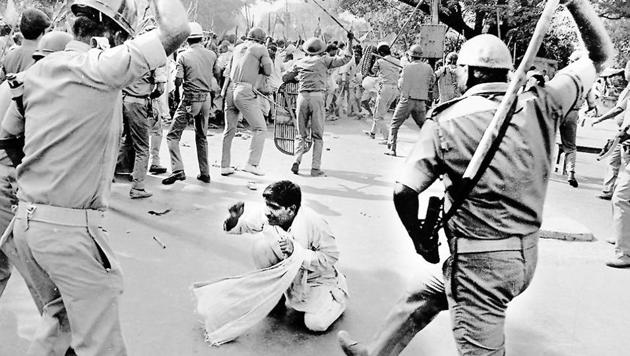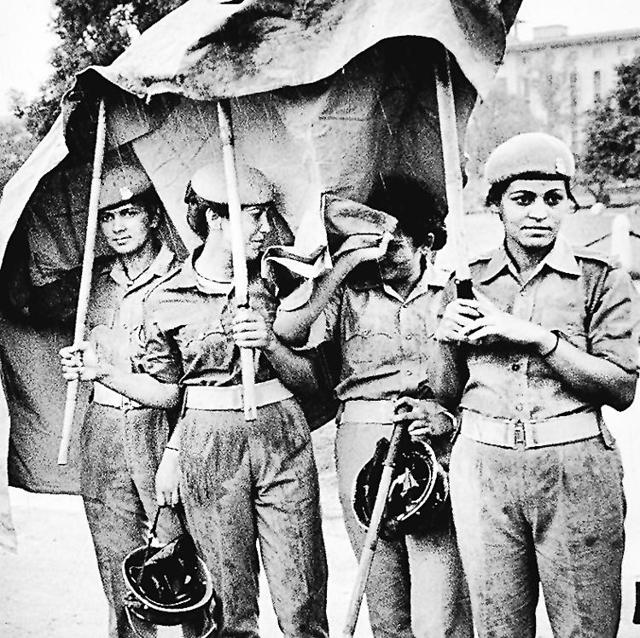Symbol of power and control, a lathi story
When Mahatma Gandhi, the father of the nation, visited Ghorghat village in Bihar’s Munger district in 1934, the villagers wished to gift him a lathi.
When Mahatma Gandhi, the father of the nation, visited Ghorghat village in Bihar’s Munger district in 1934, the villagers wished to gift him a lathi.

The Mahatma said he would accept it only under one condition — the villagers would have to stop making lathis in the interest of the nation as it was the Britishers’ weapon of choice against unarmed freedom fighters.
At that time, Ghorghat made and supplied lathis all across north India. The villagers readily agreed and Gandhi accepted their gift. Ever since, the village celebrates a ‘lathi mahotsav’ to commemorate the gifting of a lathi to the Mahatma.
Their decision, however, did not stop the colonial rulers as they found other sources.
Lathi-charge regularly made headlines during the colonial rule-- and it continues to do so 72 years after Independence, most recently as the anti-Citizenship Amendment Act (CAA) protests intensified across the country.
The lathi was introduced by the British in the late 19th century and used extensively from the 1920s to the 1940s to crush dissent and disrupt protest marches by freedom fighters.
“It was given to the colonial constabulary as most of them came from the peasant classes. They were specially trained in the use of lathi through proper drills. The lathi became a symbol of the British Raj,” says historian Anirudh Deshpande.
In 1928, police officer James Scott lathi-charged a protest march led by Lala Lajpat Rai —hailed as the Lion of Punjab — against the Simon Commission. Rai suffered severe head injuries, which led to his death.
But it had no sobering effect on the colonial police, and its use of the lathi as a weapon against freedom fighters only increased. In the 1930s, the British came up with a lathi drill for the police that consisted of commands such as “jabbing” (hitting people in the gut), “cutting” (targetting the neck and head).
“There was a massive lathi-charge on the freedom fighters during the Dandi March led by Mahatma Gandhi,” says Deshpande.
So brutal was the use of the lathi that Henry Noel Brailsford, a British left-wing journalist wrote an essay “India under the Lathi”, describing how the country was witnessing a repressive reign of lathi.
“During the struggle for Independence, nationalists passively accepted the blows that the colonial police rained down on them, as a form of satyagraha. Their cause – the overthrow of the colonial state – was just, and this made the injustice of the assault on them more unjust,” he wrote.

A symbol of power
Last week, an image of young women attempting to shield a student as the police rained lathi blows on him, went viral. It showed defiance of the youth in the face of the lathi’s tyranny.
The lathi first originated as a martial art weapon in ancient India—and continues to be part of sports, drills, and parades.
It has not just been a weapon of the police, but also many zamidars (feudal lords) who hired lathaits (men trained in lathi fights), often using them to keep a leash on tenants (worker- peasants), to grab land and collect rent.
The more lathaits a zamindar had, the more powerful he was. Lathi’s significance in rural India is summed up by the popular adage — jiski lathi, uski bhais (The one who wields the lathi owns the buffalo).
“The lathi was an integral part of peasant life. Trained ‘laithats’ from Bihar and UP were employed by zamindars in Bengal,” says Deshpande.
The lathi continues to be a symbol of farmers’ power too in modern times – many farmer organisations and other outfits have often taken out what they call ‘Lathi Rallies’.
An outdated weapon?
Many believe that the police lathis should be replaced with shorter, lighter batons across the country. A case in point would be the recent riots in Hong Kong, when security forces were seen using arm-length batons.
But Prakash Singh, former DGP of Uttar Pradesh Police, believes that as of now there is no perfect substitute to the lathi yet.
“A policeman will have to get very close to a protesting crowd to use a baton, which is dangerous in Indian conditions. In India, the mobs are huge and violent,” says Singh.
“But yes, the police should follow the proper drill of using the lathi. We were trained to move together in a formation when dispersing a mob. It helps push back the crowds without much danger to policemen. Lathis are not supposed to be used to beat individual protesters.”
The Delhi Police says it has been phasing out the old wooden sticks since 2013. Today, it has about 85,000 polycarbonate lathis, and about 15,000 bamboo ones.
Deepak Mishra, former special commissioner of Delhi Police, said that the Delhi Police switched to polycarbonate lathis due to supply constraints.
“There wasn’t enough supply of bamboo lathis , which mostly came from northeastern states such as Assam and Tripura, so we shifted to polycarbonate lathis,” he said.
However, a senior Delhi police officer, who asked not to be named, said one of the main reasons for phasing out the bamboo lathis is to reduce the chances of injury.
“The impact of bamboo lathi sometimes may result in fatality if the person is hit hard on the head. Its impact is visible on the body as it leaves scars on the skin,” said the officer.
But police constables still swear by “the good old’ bamboo lathi”.
“It is wrong to assume that crowd control is the only use of lathis. Over the years I have used it to deal with unruly rickshaw pullers and auto drivers creating traffic jams. The bamboo lathi instills a fear, and my waving it menacingly more often than not resolves the problem, ” says a Delhi police constable not wishing to be named.
Guarding with lathi
Kunwar Vikram Singh, chairman, Central Association of Private Security Industry ( CAPSI), says that the lathi is the most important tool in the private security guard’s kit—in most cases their only weapon.
“In the past, guards on night duty used to move with a lantern in one hand and a lathi in other. For security guards, it is mostly an instrument of defence and not attack. Lathi is part of our training manual for security guards. The ideal length of a lathi is the height of the person using it for better manoeuvre,” says Singh.
And like the police constables, most private security guards will tell you how a bamboo lathi helps them scare away the trouble makers.
“I make sure that I whack the lathi on the ground every few minutes in the night to convey to potential thieves that I am armed and awake. The sound of big solid lathi hitting the ground keeps them away,” says Rajesh Singh, who is posted as a guard in a market in Noida. “I will feel very unsafe without it.”
The lathi business
There are wholesale traders on the outskirts of the city in places such as Bawana , Najafgarh, and Chhatarpur who sell lathis. They say they procure their lathis from Meerut , where there are some units that manufacture lathis.
Deepak Gupta, who runs BambooMart in Samaypur Badli says that while police may be phasing out bamboo lathis, private security agencies still buy a lot of them.
“Polycarbonate lathis have not affected our sales. Our lathis cost ₹50 to ₹80 depending on the size and quality,” he says.
Anuj Gupta, owner of Roorkee-based GM Trading Company that supplies polycarbonate lathis to Delhi Police, says, “Bamboo lathis had many other issues such as finding a straight lathi of the right weight and thickness. Polycarbonate lathis do not have such issues. To make polycarbonatnate lathis, long pipes are cut into size as per demand. A handle and support are fixed and the lathi is ready,” said Anuj Gupta.
Stay updated with all top Cities including, Bengaluru, Delhi, Mumbai and more across India. Stay informed on the latest happenings in World News along with Delhi Election 2025 and Delhi Election Result 2025 Live, New Delhi Election Result Live, Kalkaji Election Result Live at Hindustan Times.
Stay updated with all top Cities including, Bengaluru, Delhi, Mumbai and more across India. Stay informed on the latest happenings in World News along with Delhi Election 2025 and Delhi Election Result 2025 Live, New Delhi Election Result Live, Kalkaji Election Result Live at Hindustan Times.






